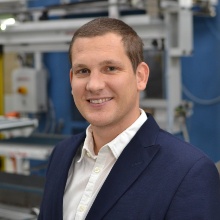Kontakt
Holzgartenstraße 17
70174 Stuttgart
Deutschland
Raum: 4.001
Fachgebiet
- Scherschneiden
2025
- Vogel-Heuser, B., Zhang, M., Krueger, M., Vicaria, A., Gardill, M., Jiang, Y., Trächtler, A., Peters, H., Liewald, M., Schenek, A., Heinzelmann, P., & Weyrich, M. (2025). DSL4DPiFS – Eine Grafische Notation zur Modellierung von Daten-Pipelines in der Umformtechnik. At-Automatisierungstechnik, 73, Article 4. https://doi.org/10.1515/auto-2024-0114
2024
- Goerz, M., Schenek, A., Quan, V. T., Riedmueller, K. R., & Liewald, M. (2024). Determining the residual formability of shear-cut sheet metal edges by utilizing an ML based prediction model. Materials Research Proceedings, 41, 1799–1806. https://doi.org/10.21741/9781644903131-199
- Schenek, A. (2024). Surrogat-Modelle zur Auslegung und Optimierung einhubiger Scherschneidprozesse (I. f. U. Universitaet Stuttgart, Ed.). http://dx.doi.org/10.18419/opus-15357
- Tchasse, P., Schenek, A., Riedmüller, K. R., & Liewald, M. (2024). Detection of Defective Deep Drawn Sheet Metal Parts by Using Machine Learning Methods for Image Classification. Production at the Leading Edge of Technology, 84–93. https://doi.org/10.1007/978-3-031-47394-4_9
2023
- Bauernhansl, T., Verl, A., Liewald, M., & Möhring, H.-C. (2023). Production at the leading edge of technology (1 ed.). Springer International Publishing.
- Schenek, A., Görz, M., Liewald, M., & Riedmüller, K. R. (2023). Application of a neural network for predicting the cutting surface quality of punching processes based on tooling parameters. IOP Conference Series: Materials Science and Engineering, 1284, Article 1. https://doi.org/10.1088/1757-899X/1284/1/012014
- Görz, M., Schenek, A., Liewald, M., & Riedmüller, K. R. (2023). Evaluation of Feature Engineering Methods for the Prediction of Sheet Metal Properties from Punching Force Curves by an Artificial Neural Network. Characterization of Minerals, Metals, and Materials 2023, 75–88. https://doi.org/10.1007/978-3-031-22576-5_8
- Görz, M., Schenek, A., Liewald, M., & Riedmüller, K. R. (2023). Einsatz von ML beim Scheren im offenen Schnitt/Use of ML in shearing with an open cutting line. Wt Werkstattstechnik Online, 113, Article 10. http://dx.doi.org/10.37544/1436-4980-2023-10-6
- Schenek, A., Görz, M., Liewald, M., & Riedmüller, K. R. (2023). Prediction of Cutting Surface Parameters in Punching Processes Aided by Machine Learning. TMS 2023 152nd Annual Meeting & Exhibition Supplemental Proceedings, 607–619. https://doi.org/10.1007/978-3-031-22524-6_54
- Schenek, A., Senn, S., & Liewald, M. (2023). Numerical and Experimental Investigations to Increase Cutting Surface Quality by an Optimized Punch Design. In M. Liewald, A. Verl, T. Bauernhansl, & H.-C. Möhring (Eds.), Production at the Leading Edge of Technology (pp. 179–188). Springer International Publishing. https://doi.org/10.1007/978-3-031-18318-8_19
- Schenek, A., Senn, S., & Liewald, M. (2023). Erhöhung der Schnittflächenqualität mittels Hohlschneiden. Europäische Forschungsgesellschaft für Blechverarbeitung e.V. (EFB). https://www.efb.de/efb-forschungsbericht-nr-593.html
2022
- Schenek, A., Görz, M., Liewald, M., & Riedmüller, K. R. (2022). Data-driven derivation of sheet metal properties gained from punching forces using an artificial neural network. Key Engineering Materials, 926, 2174–2182. https://doi.org/10.4028/p-41602a
- Liewald, M., Briesenick, D., Senn, S., & Schenek, A. (2022). Shearing of sheet metal under special attention of compressive stresses. Proceedings of the 41st SENAFOR Conference.
2021
- Schenek, A., & Liewald, M. (2021). Punching with a slant angle - cutting surface quality. Esaform 2021. https://doi.org/10.25518/esaform21.455
- Liewald, M., & Schenek, A. (2021). Production of Thin Outer Skin Car Body Panels by Using Novel Short Cycle Stretch-Forming (SCS) Technology. In P. Weißgraeber, F. Heieck, & C. Ackermann (Eds.), Advances in Automotive Production Technology -- Theory and Application (pp. 286–292). Springer Berlin Heidelberg. https://doi.org/10.1007/978-3-662-62962-8_33
- Schenek, A., & Liewald, M. (2021). Scherschneiden – Auslegung von Schneidkantenradien. WT WerkstattsTechnik, Article 10. https://doi.org/10.37544/1436–4980–2021–10
2020
- Schenek, A., Senn, S., & Liewald, M. (2020). Lochen mit Blechlagewinkel -- Methodenoptimierung/Punching with a slant angle -- a novel approach in process design. Wt Werkstattstechnik Online, 110, Article 10. https://doi.org/10.37544/1436-4980-2020-10-45
- Schenek, A., Opitz, M., & Hohlfelder, C. (2020). Innovatives HSC-Fertigungsverfahren reduziert die Kantenrissempfindlichkeit von Formplatinen und ermöglicht neue Blechbauteilspektren. Der Schnitt- Und Stanzwerkzeugbau, 02/2020.
- Schäuble, T., & Schenek, A. (2020). Digitalization - and then? In M. Liewald (Ed.), New Developments Sheet Metal Forming. Institute for Metal Forming Technology.
2019
- Schenek, A., Liewald, M., & Senn, S. (2019). Identification of process limits for punching with a slant angle. IOP Conference Series: Materials Science and Engineering, 651, Article 1. https://doi.org/10.1088/1757-899X/651/1/012066
- Schenek, A., Senn, S., & Liewald, M. (2019). Prozessgrenzen und Parameter für das Lochen mit Blechlagewinkel. In Wirtschaftliche Verarbeitung hochfester Blechwerkstoffe für Leicht und Funktionsbau. Europäische Forschungsgesellschaft für Blechverarbeitung e.V. (EFB).
- Schenek, A., Senn, S., & Liewald, M. (2019). EFB-Merkblatt 4228 - Schneidparameter beim Lochen mit Blechlagewinkel von hochfesten Blechwerkstoffen. In EFB-Merkblatt. Europäische Forschungsgesellschaft für Blechverarbeitung e.V. (EFB). https://shop.efb.de/Schneidparameter-beim-Lochen-mit-Blechlagewinkel-von-hochfesten-Blechwerkstoffen/MB-4228-0
2018
- Schenek, A., Senn, S., & Liewald, M. (2018). Erweiterung der Prozessgrenzen beim Lochen mit Blechlagewinkel von hochfesten Blechwerkstoffen. Europäische Forschungsgesellschaft für Blechverarbeitung e.V. (EFB). https://www.efb.de/efb-forschungsbericht-nr-503.html


